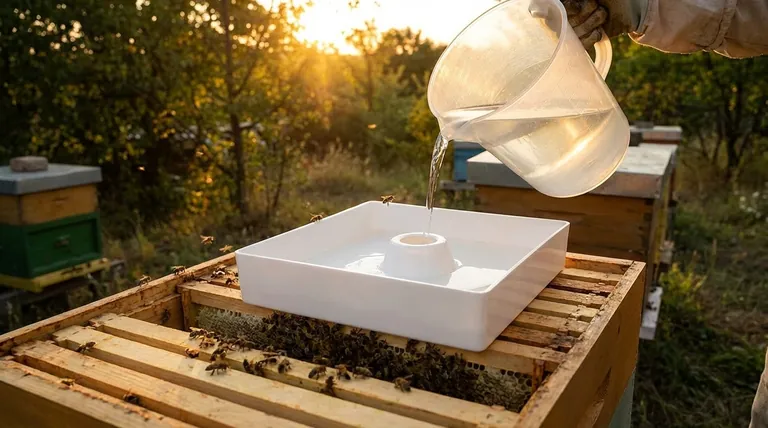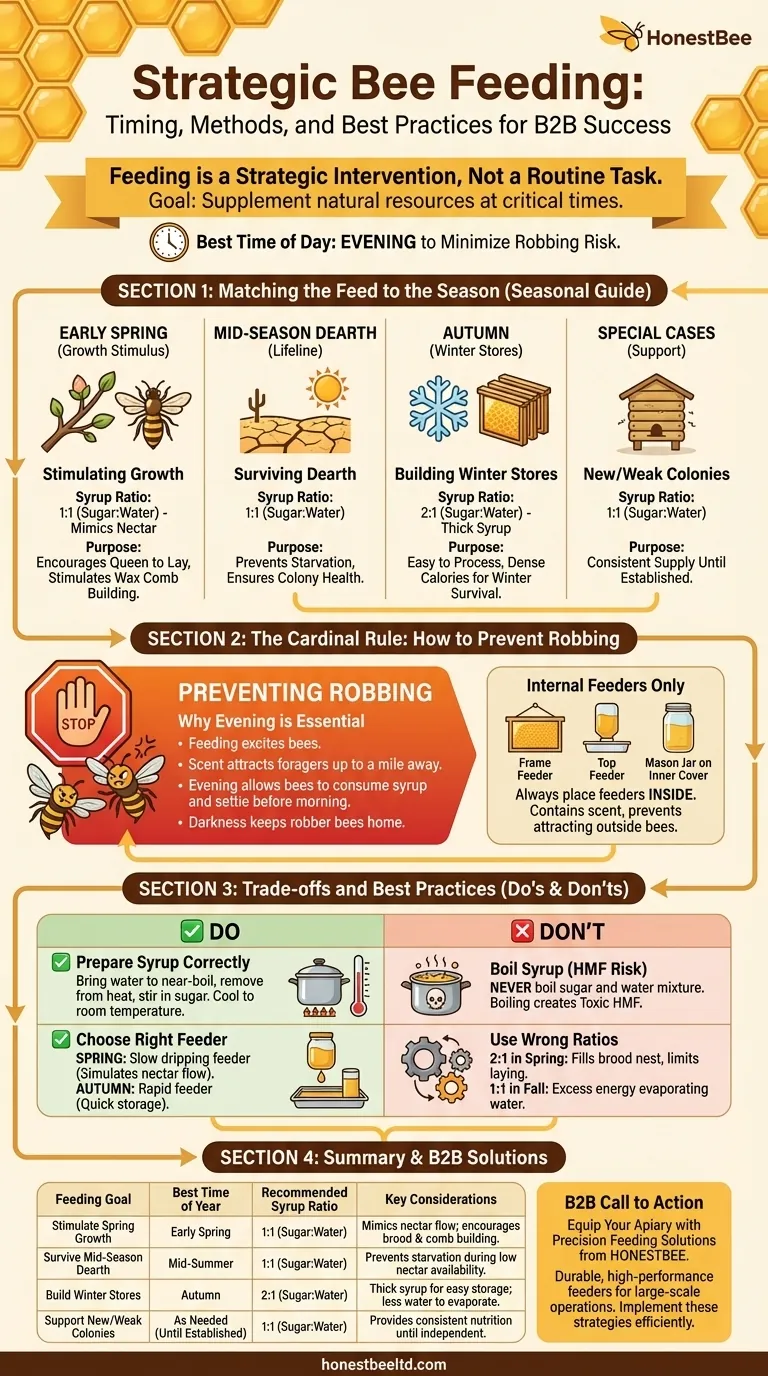Timing is critical when feeding bees. The best time of day to feed is always in the evening to minimize the risk of robbing from other hives. The best time of year depends entirely on your colony's needs, whether it's encouraging growth in the spring, surviving a nectar dearth, or preparing for overwintering in the autumn.
Feeding bees is a strategic intervention, not a routine task. The goal is to supplement natural resources at critical times, using the right sugar concentration to either simulate a nectar flow for growth or provide dense calories for storage.

Matching the Feed to the Season
Understanding the "why" behind feeding is essential for supporting your colony's natural cycle. The bees' needs change dramatically throughout the year, and your feeding strategy must adapt accordingly.
Early Spring: Stimulating Colony Growth
In early spring, a 1:1 syrup (equal parts sugar and water by weight) mimics natural nectar. This thin syrup does not primarily serve as a food store.
Instead, it stimulates the queen to lay eggs and encourages worker bees to begin building out new wax comb in preparation for the season's first major nectar flow.
Mid-Season Dearth: Providing a Lifeline
A dearth is a period when few nectar-producing flowers are in bloom, often occurring in the heat of mid-summer.
During a dearth, a strong colony can quickly consume its stores. Providing 1:1 syrup can prevent starvation and ensure the colony remains populous and healthy.
Autumn: Building Winter Stores
In the fall, the goal is to help bees stock up for winter. A thick 2:1 syrup (two parts sugar to one part water) is ideal for this purpose.
This heavier syrup has less water for the bees to evaporate, making it easier for them to process and cap as winter food.
Special Cases: New or Weak Colonies
New nucleus hives or weak colonies often lack the foraging workforce to sustain themselves. They benefit from a consistent supply of 1:1 syrup until they become established and can forage effectively on their own.
The Cardinal Rule: How to Prevent Robbing
Feeding bees can trigger a dangerous behavior known as robbing, where bees from stronger hives attack a weaker hive to steal its food stores. Preventing this is a beekeeper's top priority.
Why Evening is Essential
Feeding excites bees and the smell of sugar can attract foragers from hives up to a mile away.
By placing feed in the hive towards evening, your bees have all night to consume some of the syrup and settle down. The falling temperatures and darkness ensure that robber bees from other colonies stay home.
The Importance of Internal Feeders
Always place feeders inside the hive. Common types include frame feeders, top feeders, or simple Mason jars placed over the inner cover.
This contains the scent of the syrup and prevents attracting outside bees, drastically reducing the chance of initiating a robbing frenzy.
Understanding the Trade-offs and Best Practices
Properly preparing and delivering feed is just as important as knowing when to provide it. Mistakes can be stressful or even harmful to your bees.
The Risk of Creating HMF
When preparing syrup, never boil the sugar and water mixture. Boiling can produce Hydroxymethylfurfural (HMF), a compound that is toxic to bees.
The correct method is to bring the water to a near-boil, remove it from the heat, and then stir in the sugar until it is completely dissolved. The syrup must cool to room temperature before being given to the bees.
Choosing the Right Feeder
The type of feeder should match your goal.
In the spring, a slow dripping feeder (like a Mason jar with small holes in the lid) is best. This slow delivery simulates a nectar flow. In the fall, a rapid feeder allows the colony to quickly take down large quantities of 2:1 syrup for storage.
Syrup Ratios Are Not Interchangeable
Using the wrong syrup at the wrong time can be counterproductive.
Feeding heavy 2:1 syrup in the spring can cause the bees to store it in the brood nest, limiting the queen's laying space. Feeding thin 1:1 syrup in the fall forces the bees to expend excess energy evaporating water they don't need.
Making the Right Choice for Your Hive
Your decision to feed should always be based on a clear goal for the colony.
- If your primary focus is stimulating a spring buildup: Use a slow, dripping feeder with a 1:1 sugar-to-water syrup.
- If your primary focus is helping bees build winter stores: Use a rapid feeder with a heavy 2:1 sugar-to-water syrup in the fall.
- If your primary focus is supporting a new or weak colony: Provide a consistent source of 1:1 syrup until they are well-established.
- If your primary focus is avoiding robbing at all costs: Always place feeders inside the hive and only add or refill them in the late evening.
By understanding your colony's needs and feeding with purpose, you transition from simply keeping bees to managing them effectively.
Summary Table:
| Feeding Goal | Best Time of Year | Recommended Syrup Ratio | Key Considerations |
|---|---|---|---|
| Stimulate Spring Growth | Early Spring | 1:1 (Sugar:Water) | Mimics nectar flow; encourages brood rearing and comb building. |
| Survive Mid-Season Dearth | Mid-Summer | 1:1 (Sugar:Water) | Prevents starvation during low nectar availability. |
| Build Winter Stores | Autumn | 2:1 (Sugar:Water) | Thick syrup for easy storage; less water to evaporate. |
| Support New/Weak Colonies | As Needed (Until Established) | 1:1 (Sugar:Water) | Provides consistent nutrition until colony can forage independently. |
Equip Your Apiary with Precision Feeding Solutions from HONESTBEE
Whether you manage a commercial apiary or distribute beekeeping equipment, proper feeding is key to colony success. HONESTBEE supplies durable, high-performance feeders and essential supplies designed for large-scale operations. From internal frame feeders to rapid top feeders, our products help you implement the strategies outlined above efficiently and safely.
Ready to enhance your feeding protocol and boost hive productivity? Contact our expert team today to discuss wholesale pricing and tailored solutions for your beekeeping needs.
Visual Guide

Related Products
- HONESTBEE Professional Hive Top Bee Feeder Feeding Solution
- HONESTBEE Entrance Bee Feeder Professional Hive Nutrition Solution for Beekeeping
- HONESTBEE Professional Long Handled Hive Tool with Precision Cutting Blade
- Rapid Bee Feeder White Plastic 2L Round Top Feeder for 8 or 10-Frame Bee Hives
- HONESTBEE Round Hive Top Bee Feeder for Syrup
People Also Ask
- What safety features are included in top feeders? A Guide to Drowning Prevention and Hive Safety
- Do I need an inner cover with a hive top feeder? Optimize Your Hive Setup for Healthy Bees
- What is a top feeder for bees? Maximize Colony Health with Efficient Feeding
- Why is a top feeder essential for bees? Ensure Colony Health and Efficiency
- What should be done with feeders and equipment after feeding bees? Essential Steps for Apiary Health



















